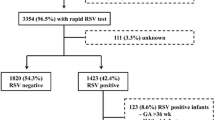Abstract
The aim of this study was to determine whether respiratory syncytial virus (RSV) and other viral lower respiratory tract infections (LRTI) in prematurely born infants were associated with similar effects on healthcare utilisation and related cost of care in the second compared to the first year after birth. Thirteen infants who had RSV LRTIs (RSV), 21 who had other viral LRTIs (other viral) and 25 had no viral LRTIs (no LRTI) were prospectively followed. Nasopharyngeal aspirates were collected whenever an infant had an LRTI regardless of whether it was in the hospital or in the community. Healthcare utilisation and the health-related cost of care were determined. Only the RSV group compared to the no LRTI group had higher overall respiratory costs in both year 1 (mean, £3,917 versus £24; p < 0.041) and year 2 (mean, £1,164 versus £61; p = 0.012). Only the RSV group required respiratory admissions; the RSV admission rate in year 2 was 3.4 % (number needed to treat 59). Conclusion: RSV LRTIs are associated with increased healthcare utilisation and cost of care in the first and second year; nevertheless, if prophylaxis is to be cost-effective in the second year, a high risk group needs to be identified.

Similar content being viewed by others
Abbreviations
- BPD:
-
Bronchopulmonary dysplasia
- LRTI:
-
Lower respiratory tract infection
- NNT:
-
Number needed to treat
- NPA:
-
Nasopharyngeal aspirate
- PCR:
-
Polymerase chain reaction
- RSV:
-
Respiratory syncytial virus
- RV:
-
Rhinovirus
References
Barber J, Thompson S (2004) Multiple regression of cost data: use of generalised linear models. J Health Serv Res Policy 9:197–204
Blanken MO, Rovers MM, Molenaar JM, Winkler-Seinstra PL, Meijer A, Kimpen JL, Bont L, Dutch RSV, Neonatal Network (2013) Respiratory syncytial virus and reucrrent wheeze in health preterm infants. N Engl J Med 368:1791–9
Broughton S, Roberts A, Fox G, Pollina E, Zuckerman M, Chaudhry S, Greenough A (2005) Prospective study of healthcare utilisation and respiratory morbidity due to RSV infection in prematurely born infants. Thorax 60:1039–44
Department of Health (2009) NHS reference costs 2007-08. NSRC04 NHS Trust and PCT Combined Reference Cost Schedules. [Internet]. Dep. Heal. website. Available from: http://www.dh.gov.uk/prod_consum_dh/groups/dh_digitalassets/documents/digitalasset/dh_098951.xls
Drysdale SB, Alcazar-Paris M, Wilson T, Smith M, Zuckerman M, Broughton S, Rafferty GF, Peacock JL, Johnston SL, Greenough A (2013) Rhinovirus infection and healthcare utilisation in prematurely born infants. Eur Respir J 42:1029–36
Drysdale S, Wilson T, Alcazar M, Broughton S, Zuckerman M, Smith M, Rafferty GF, Johnston SL, Greenough A (2011) Lung function prior to viral lower respiratory tract infections in prematurely born infants. Thorax 66:468–73
Greenough A, Alexander J, Boit P, Boorman J, Burgess S, Burke A, Chetcuti PA, Cliff I, Lenney W, Lytle T, Morgan C, Raiman C, Shawn NJ, Sylvester KP, Turner J (2009) School age outcome of hospitalisation with respiratory syncytial virus infection of prematurely born infants. Thorax 64:490–5
Groothuis JR, Gutierrez KM, Lauer BA (1988) Respiratory syncytial virus infection in children with bronchopulmonary dysplasia. Pediatrics 82:199–203
The IMpact-RSV Study Group (1998) Palivizumab, a humanized respiratory synctyial virus monoclonal antibody reduces hospitalization from respiratory syncytial virus infection in high risk infants. Pediatrics 102:531–7
Lanari M, Adorni F, Silvestri M, Coscia A, Musicco M: Italian Study Group on Risk Factors for RSV-Related Hospitalization (2011) The multicenter Italian birth cohort study on incidence and determinants of lower respiratory tract infection hospitalization in infants at 33 weeks GA or more: preliminary results. Early Hum Dev 875:S43–6
Patel DS, Paris MA, Watson F, Peacock JL, Campbell M, Greenough A (2012) RSV hospitalisation and healthcare utilisation in moderately prematurely born infants. Eur J Pediatr 171:1055–61
Royal College of Paediatrics and Child Health (2008) British National Formulary for Children (BNFC) 2008. BMJ Group, RPS Publishing, RCPCH Publications Ltd
Sigurs N, Aljassim F, Kjellman B, Robinson PD, Sigurbergsson F, Bjarnason R, Gustafsson PM (2010) Asthma and allergy patterns over 18 years after severe RSV bronchiolitis in the first year of life. Thorax 65:1045–52
Stein RT, Sherrill D, Morgan WJ, Holberg CJ, Halonen M, Taussig LM, Wright AL, Martinez FD (1999) Respiratory syncytial virus in early life and risk of wheeze and allergy by age 13 years. Lancet 354:541–5
Thomas M, Bedford-Russell A, Sharland M (2000) Hospitalisation for RSV infection in ex-preterm infants—implications for use of RSV immune globulin. Arch Dis Child 83:122–7
Thompson SG, Barber JA (2000) How should cost data in pragmatic randomised trials be analysed? BMJ 320(7243):1197–200
Wang EE, Law BJ, Stephens D (1995) Pediatric Investigators Collaborative Network on Infections in Canada (PICNIC) prospective study of risk factors and outcomes in patients hospitalized with respiratory syncytial viral lower respiratory tract infection. J Pediatr 126:212–9
Funding source
The research was funded/supported by the National Institute for Health Research (NIHR) Biomedical Research Centre based at Guy's and St Thomas' NHS Foundation Trust and King's College London. The views expressed are those of the author(s) and not necessarily those of the NHS, the NIHR or the Department of Health. AG is an NIHR Senior Investigator.
Conflict of interest
AG has received grant funding from Abbott Laboratories and MedImmune.
Author information
Authors and Affiliations
Corresponding author
Additional information
Communicated by Patrick Van Reempts
Rights and permissions
About this article
Cite this article
Drysdale, S.B., Alcazar-Paris, M., Wilson, T. et al. Viral lower respiratory tract infections and preterm infants’ healthcare utilisation. Eur J Pediatr 174, 209–215 (2015). https://doi.org/10.1007/s00431-014-2380-9
Received:
Revised:
Accepted:
Published:
Issue Date:
DOI: https://doi.org/10.1007/s00431-014-2380-9




